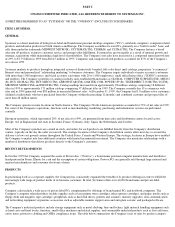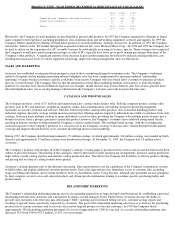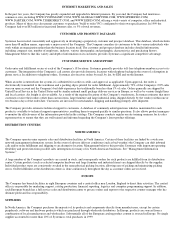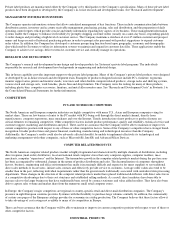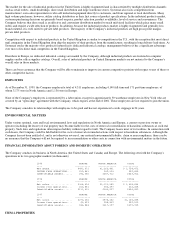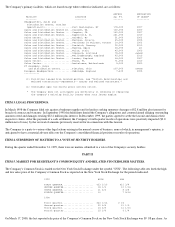Circuit City 1999 Annual Report Download - page 13
Download and view the complete annual report
Please find page 13 of the 1999 Circuit City annual report below. You can navigate through the pages in the report by either clicking on the pages listed below, or by using the keyword search tool below to find specific information within the annual report.INTERNAL SYSTEMS
The Company has tested and, as necessary, repaired or replaced its internal PC hardware/software and computer network systems, and
management believes that they are now Y2K compliant. The Company's phone systems have been tested and are Y2K compliant. The
Company's internal business systems in both North America and Europe are Y2K compliant.
The Company contacted its key vendors and service providers to ascertain their Y2K compliance to the extent that their problems could affect
the Company's internal systems or other aspects of its business. Inquiry letters were sent to all key vendors and service providers. Positive
responses or other assurances were received from all of our significant vendors and service providers.
PRODUCTS SOLD
The Company questioned its vendors as to the Y2K compliance status of the brand name (i.e. third party-manufactured) hardware and software
products it sells. This includes the brand name software that is pre-loaded onto the private label PCs the Company sells. Substantially all of the
Company's significant vendors have indicated that their products are Y2K compliant although the Company makes no warranties to customers
regarding the Y2K compliance of third-party manufactured products.
IMPLICATIONS TO THE COMPANY FROM THE ADOPTION OF A EUROPEAN COMMON CURRENCY
The Company has extensive operations in certain European countries, including France, Germany, Italy, the Netherlands, Spain, Sweden,
England and Scotland. It also sells to additional countries in Europe. For the 1999 fiscal year, approximately 28% of the Company's net sales
were in Europe. With the exception of Sweden and the United Kingdom, all of the countries in which the Company has operations have
confirmed their participation in a new 11-country European common currency, the Euro. The adoption of such common currency is being
phased in over a three-year period which started in January 1999. During such phase-in period, both the Euro and the historical currency of a
country will be valid, although new Euro- denominated currency will not be issued until 2002. Each member-country will decide when its
legacy currency will cease to be legal tender, which will occur during the period January 1 through June 30, 2002. Until the introduction of
Euro-denominated currency, the paying party will have the option to decide whether to pay in the legacy currency or in Euros converted to the
legacy currency.
Among other possible economic implications, it is expected that the adoption of a common currency will generally lead to greater price
transparency and thereby increased competition within the common currency zone. For instance, with a single currency applicable to the entire
region, consumers may be able to more easily discern differences in price for the Company's products between different countries and modify
their buying practices accordingly. This is less likely to be a factor for the Company than for many other companies since the Company
currently only advertises the Euro price on its Internet sites, not in its catalogs. Also, purchasers of low cost individual products are less likely
to shop for a lower Euro price outside of their geographic location. The Company will still use national catalogs, in the appropriate language,
notwithstanding the introduction of the Euro. Whether any such price differentials will lead to significant changes in purchasing practices by
the Company's customers depends on other factors as well, such as convenience, language-related matters and other factors which may
determine where a consumer will purchase products. The Company does not believe at this time that the introduction of the Euro will have any
significant long-term adverse impact on the pricing for the Company's products or require a significant modification to the Company's
accounting systems.
FORWARD LOOKING STATEMENTS
This report contains forward looking statements within the meaning of that term in the Private Securities Litigation Reform Act of 1995
(Section 27A of the Securities Act of 1933 and Section 21E of the Securities Exchange Act of 1934). Additional written or oral forward
looking statements may be made by the Company from time to time, in filings with the Securities Exchange Commission or otherwise.
Statements contained herein that are not historical facts are forward looking statements made pursuant to the safe harbor provisions referenced
above. Forward looking statements may include, but are not limited to, projections of revenue, income or loss and capital expenditures,
statements regarding future operations, financing needs, compliance with financial covenants in loan agreements, plans for acquisition or sale
of assets or businesses and consolidation of operations of newly acquired businesses, and plans relating to products or services of the Company,
assessments of materiality, predictions of future events and the effects of pending and possible litigation, as well as assumptions relating to the
foregoing. In addition, when used in this discussion, the words "anticipates", "believes", "estimates", "expects", "intends", "plans" and
variations thereof and similar expressions are intended to identify forward looking statements.
Forward looking statements are inherently subject to risks and uncertainties, some of which cannot be predicted or quantified based on current
expectations. Consequently, future events and actual results could differ materially from those set forth in, contemplated by, or underlying the
forward looking statements contained in this report. Statements in this report, particularly in "Item 1. Business", "Item 3. Legal Proceedings",
"Item 7. Management's Discussion and Analysis of Financial Condition and Results of Operations", and the Notes to Consolidated Financial
Statements describe certain factors, among others, that could contribute to or cause such differences. Other factors that could contribute to or
cause such differences include, but are not limited to, unanticipated developments in any one or more of the following areas: (i) the Company's
ability to manage rapid growth as a result of internal expansion and strategic acquisitions, (ii) the effect on the Company of volatility in the
price of paper and periodic increases in postage rates, (iii) the operation of the Company's management information systems, (iv) the general
risks attendant to the conduct of business in foreign countries, including currency fluctuations associated with sales not denominated in United
States dollars, (v) significant changes in the computer products retail industry, especially relating to the distribution and sale of such products,
(vi) competition in the PC, notebook computer, computer related products, industrial products and office products markets from superstores,



